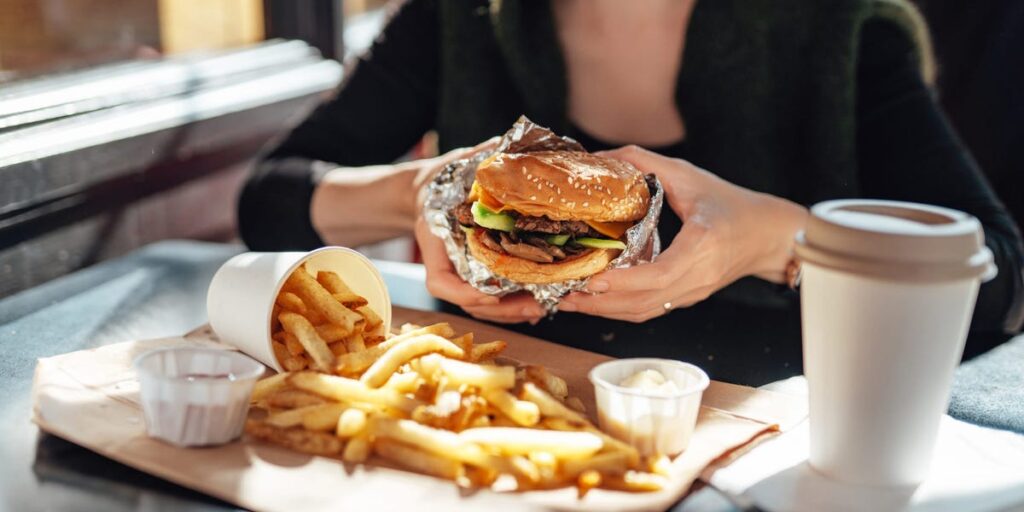- Beef prices in the US are rising due to a historic drought and herd liquidation.
- Fast food chains like McDonald’s and Burger King have already raised prices due to inflation.
- Consumers may not see lower burger prices until 2027 or 2028, when beef supplies could recover.
Inflation has not been kind to food prices — especially for eating out.
According to the consumer price index, food away from home rose 4% in the 12 months to August — higher than gains in both grocery store prices and the overall CPI.
Starbucks, McDonald’s, KFC, In-N-Out, and Olive Garden are among the chains that have raised prices due to the soaring cost of labor and commodities.
McDonald’s CEO Chris Kempczinski said in July that a fall in sales in the most recent quarter could partially be attributed to its food being too expensive.
In response to consumers exploring different options — like eating at home instead — restaurants have realigned efforts into value menus. Over the summer, McDonald’s and Burger King introduced $5 combo deals.
These cheaper options appeared to be popular, bolstering visits to McDonald’s stores.
But the restaurant business is facing another issue. Lance Zimmerman, a senior animal protein analyst for Rabo AgriFinance, told Business Insider that beef prices are increasing sharply.
Erin McDowell/Business Insider
The US cattle herd is at its smallest in seven decades
“The beef industry, just as it was going through the pandemic, was also going through one of the worst droughts in the US that we have ever had in the last 100 years,” he said.
As a result, suppliers began to liquidate or reduce the cow herd.
Now, beef supplies are getting tighter, meaning prices are increasing, Zimmerman said.
According to their websites, several fast food chains use American beef, including McDonald’s, Wendy’s, and Yum! Brands, which owns Pizza Hut, Taco Bell, and KFC.
Data from the Department of Agriculture revealed that the US cattle herd fell to 87.2 million at the beginning of 2024, its smallest since 1951.
The USDA reported that this led to record retail beef prices, with an all-fresh value of $8.15 per pound for July.
It’s bad news for hamburger fans.
“The reality is over the next couple of years, beef prices are going to continue to go higher,” Zimmerman said.
He said the problem is amplified by beef production struggling to keep up with population growth. Meanwhile, a rise in US exports of the meat has cut domestic supply.
The other issue is that when you liquidate cows, it takes about two years to replace them, he said. A 500-pound calf has to first more than double in size before breeding and producing its own calf, which takes another nine months, he said.
For Zimmerman, consumers will not start to see the benefits of stronger beef supplies until 2027 or 2028.
In other words, don’t count on the burger at your local restaurant getting any cheaper anytime soon.
Steak prices are also sizzling
Westend61/Getty Images
Jay Bandy, the president of Goliath Consulting Group, a Georgia-based restaurant consulting firm, told BI that beef inflation is a problem across the restaurant industry, including fine dining.
One of the group’s clients has had to raise prices on some of its key steak items, and another is considering removing steak and fries from its menu.
“The problem with beef prices is its hard to be profitable in a steak-centric restaurant,” Bandy said. “Higher-end dining is feeling more of a pinch because the market for fine dining is negative right now. It peaked earlier in the year, so they’re in the tough spot.”
He said that anyone wanting a steak should expect to pay more right now.
Restaurants should seize this opportunity to find beef alternatives
Till Dudler, managing director of global consumer goods and services strategy for Accenture, told BI that the strained beef market provides real opportunities for restaurants to update their menus.
“I haven’t seen this yet in the protein space, but in the ice cream space, some of our clients will basically change their portfolios depending on what prices are out there,” he said. That means if blueberries are cheap, expect to see more blueberry ice cream.
Dudler explained that white meat, like chicken, is generally a good substitute. He also said there are plenty of non-meat alternatives, such as lentils and chickpeas.
Chickens bred for meat grow much faster than cows and can be bred quickly.
Bandy said chicken is one of the main alternatives he has been advising his clients to use in their restaurants instead. “Chickens are easy to work with. Chicken breast and chicken thighs are fairly reasonably priced as a protein right now.”
For Dudler, it’s time for businesses that rely on beef to rethink and reinvent.



